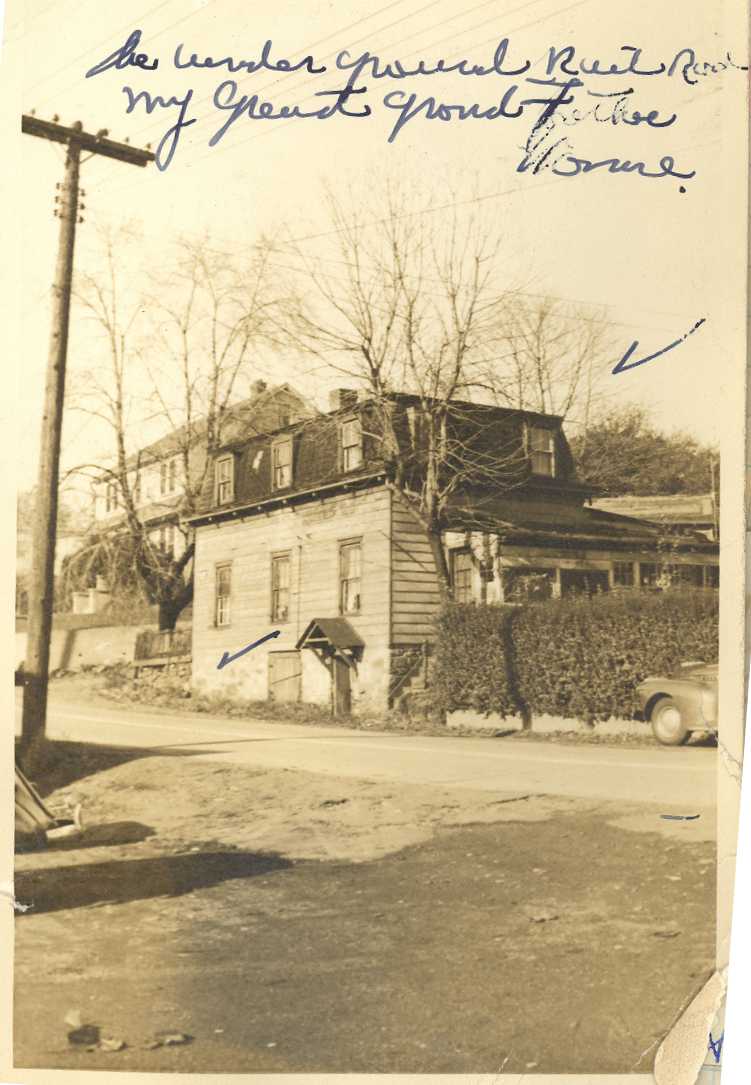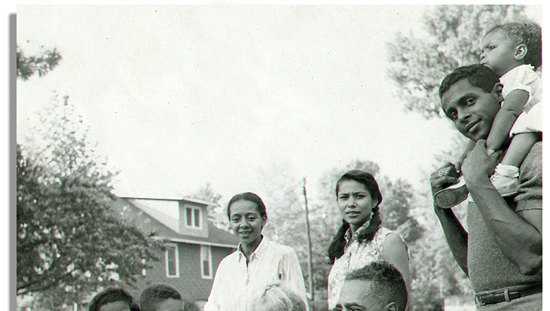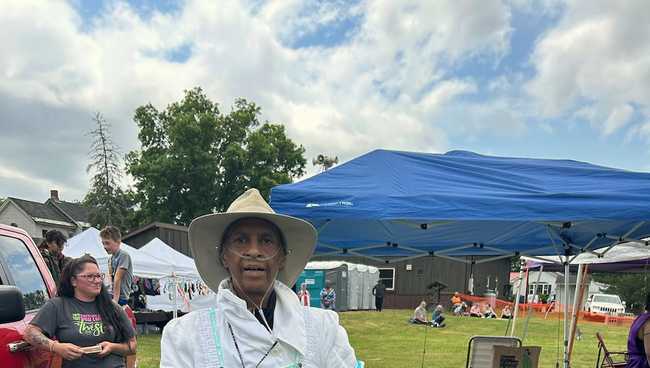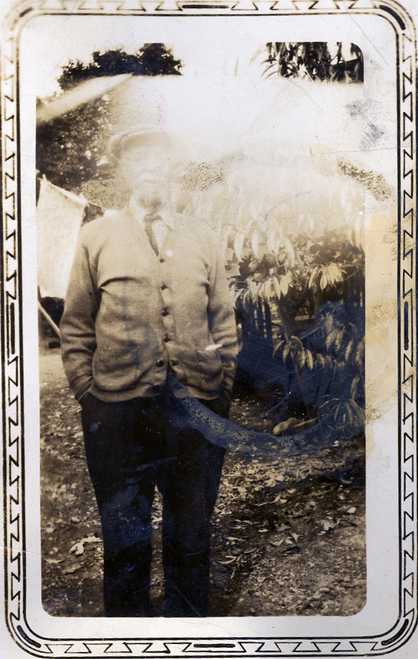
Brown Genealogy

Born ~5 March 1836 in New York - died ~9 October 1930. I'd been looking for some specific journal pages and photos that I know I had seen somewhere. I remember that they were written by "Lulu" about her grandfather. There were also 4 photos attached to the pages. I remembered that William Brown and the church he helped build were mentioned by her.
Cabrini and Gloria were looking to find out what had happened to Cornelia Brown and their grandfather's, Edward James - cousin Eddie's, story. Cabrini, Sherwood and I had just established that "cousin Eddie" was granddady's cousin and Cabrini was the little girl that used to come to the Englewood house at 125 1st street to visit along with him. She and Aunt Anna clicked and always got a taste of the eggnog when it was around. I remember Mom used to talk mention cousin Eddie sometimes but hadn't thought about it much. Now that connection was made. A puzzle piece clicked into place. So now we started to look for the trail back to Cornelia and her father.
Finally I found the scans of the journal pages that grandaddy's sister Louisa "lulu" Smith had written about William Brown Jr. I shared them over email with some cousins and we were off to the races. Finding that information was great. But it opened the door to more questions. Could we find more pieces to the puzzle. One photo on the page is of a house without any location or other frame of reference. An auto is partially visible to the right on the street. Looks like maybe a 30's or 40's model. The writing on the photo says or appears to say "the under ground rail road - My great grandfather[sic] home". Interesting. So if the reading of the handwriting is correct this is or was William Brown's house and it was involved with the underground railroad. Okay, but wait this says great grand father not grandfather. Willaim Brown Jr. was great aunt Lulu's grandfather. So who wrote that on the photo. Could it have been Thomas Brooks, Lulu's son? Someone else? I still need to find the originals if I have them. I only have the scans that are dated 2004. So that added something to the interpretation of the house in the photo. What to do? Web searches. I did some driving around on gmaps with street view but couldn't find the house in Tappan Town proper. I did find a couple of markers for The underground railroad in Tappan though. But nothing that looked like the photo.
Okay so that didn't work. Time lost spent virtually "driving" around town. I'm retired so I've got nothing more pressing to do. No "work" breathing down my neck. I had gotten close, I thought and had caught the bug. So I searched some more. I searched for some area History. Those searched turned up some local Historical societies. I concentrated on the Tappantown Historical Society (TPS) still going on the premise the house was in or near Tappan. I sent an email off to the TPS hoping for the best but realistically not expecting much. Wonder of wonders I actually got a response from the THS. Hello Mr. Miller, Thank you for the email and attached photo, it is appreciated. We were able to locate the house, it's not in Tappan but in the nearby hamlet, Sparkill. Both, Sparkill and Piermont, were known until sometime in the 19th Century as Tappan Slote. The house is located at 365 Orangeburg Rd near the intersection of two former railroads, Erie Railroad and Northern Railroad. I attached a recent photo of this house. Would you be able to provide more information about a possible connection of this house to the underground railroad? A THS member who lives in Sparkill, offered to look up the ownership history of this house.
Wow wow wow. Okay. Never expected this. So there is the house, still standing, and in Sparkill too. We knew that the Browns's were from Sparkill. The house at 365 Orangeburg Road is just a short jog away from the St. Charles AME Zion church too. Now I'm waiting to hear back from the THS with more information about the house and it's history. I'll add an update when/if it comes. Map excerpt of House 365 Orangeburg Road and St. Charles AMEZ church There is a lot of information about the St. Charles A.M.E. Zion Church of Sparkill NY. Well I say a lot but really it's known and recognized that William Brown Jr. was a member of, trustee, and builder of the Sparkill church. He was a Mason known for his skills with stone.
From Lulu's journal: this church my grandfather built
also the parishion house built by my grandfather Wm Brown Jr {photo of church} On this shot here you see this church… My Grandfather pick this shot after he was..
converted at the age of 32 years he …
in this lonely place at that time. then…
was not a house to be seen in …
he built this church he could…
building his cousin Sarah Williams put
a stove in it if ever you should go
to Sparkill you will see my Grandfathers picture and biography
there in the d…. rooms
External link: Historical marker at the St. Charles AMEZ Church Sparkill NY External link: About St. Charles AMEZ Church An excerpt from the above including William "Poppy" Brown Jr's role as trustee and in building the church: The origins of the St. Charles A.M.E. Zion Church of Sparkill, New York can be traced to the “Swamp Church” which existed in the County of Bergen, New Jersey in a section known as Harrington Township. The church at Skunk Hollow was on a site that would today be found on the present Route 340, in the Town of Orangetown, in Rockland County, New York, a few miles southwest of the site of the current church. The swamp church site had been acquired in the early 1850’s. Records show that after the church was built, Reverend William Thompson deeded the land to the “trustees of the Methodist Episcopal Church of Coulored people of the Township of Harrington” in 1856. Reportedly named St. Marks Church, the swamp church was pastored by the Reverend Thompson, popularly known as “Rev. Billy”. He was ordained at the Central Presbyterian Church in Haverstraw, New York. He was said to have been the most prosperous member of the Skunk Hollow area, also known as “The Mountain “ Community, where the members of the early congregation lived. Tradition has it that Rev. Thompson fell in love with a young slave girl, bought her and married her. This girl was named Elizabeth Thompson who became affectionately known as “Aunt Beccie or Betsy”. She lived to be 102 years old, dying in 1907. Rev. Billie was the pastor of the swamp church until his death in August, 1886. In 1889 a search was undertaken to locate the appropriate site in sparkill on which to relocate the church. Probably this came about due to the decline in the population of the community known as Skunk Hollow. Five trustees, William Brown, Jr., Charles Gaskin, George H. Williamson, Thomas Stewart and Robert James were selected by the congregation to undertake this responsibility. Though the site on which the ST. CHARLES A.M.E. ZION CHURCH now stands was at the time thought by some to be unsuited for the purpose because of the growth of underbrush, it was acquired, cleared, and construction began. The rocks of the rough stone foundation are said to have been hauled by Robert Lawson, the grandfather of one of the church’s current members, Bro. Benjamin Lawson. Funds ran out before construction was completed and work on the edifice ceased. Legend has that a Mrs. Charles Kinsley Taylor, who passed the location regularly on her way to the railroad station, noticed that work on the church had stopped and inquired why. When informed that financial problems had caused the halt to the construction, the story goes, Mrs. Taylor is said to have offered to provide the necessary funds if a parsonage would first be constructed and she be allowed to live in it and watch the building of the church. Reportedly the church was then named St. Charles A.M.E. Zion Church in memory of the late husband of Mrs. Taylor. A written agreement between Clarence G. Tilt, a builder, and George H. Williamson and William Brown, trustees of the church, affirm that Tilt agreed to supervise the work of construction of the church for the consideration of $350.00 to be paid at the start of work and $389.00 on completion. Trustee Brown, popularly known as “Poppy Brown” is known to have been a skilled mason and was no doubt the person who did the substantial masonry which went into the edifice. On the 11th day of January, 1910, a meeting was held between the members of the Methodist-Episcopal Church of Colored People, in the vicinity of Upper Piermont, New York and the Members of St. Charles A.M.E. Zion Church of Sparkill, New York, both unincorporated churches and religious organizations, to consolidate and become incorporated as a religious corporation, under and by virtue of the laws of the State of New York. The trustees who executed said certificate were John T. Matthews, Robert Lawson and William Brown, Jr. Note the reference to "The Mountain Community" more than probably an oblique reference to the so-called "Jackson Whites" in the Ramapo mountian area there on the border of NY and NJ in Rockland County and Bergen County. The original land charter for this area in 1682 was made by a group of 16 men that included "3 Negroes". External link to livingplaces site on Tappan Historic District An excerpt below: The land where Tappan (Tappantown) was established was purchased from the Native Americans on March 17, 1682. The name Tappan was conferred by the Dutch on the local group of Munsee Indians (The name first appears on maps made by the Dutch, in 1614-16, as "Top-paun"). This land purchase, which became known as the Tappan Patent, was made by a group of eight white men and three Negroes from Manhattan together with five men from New Jersey.[1] The Tappan Patent was divided into nine shares which were divided amongst the sixteen men. Each shareholder had approximately one square mile each, but the land was held in common. Although this agreement with the Native Americans was signed on July 1, 1682 in New Jersey, it was not confirmed by the colonial government until March 24, 1686, after an early state boundary line was determined. The land remained unused by the patent shareholders during this time as well. The present day center of the village (the Tappan Historic District). In 1704, eight of the original patentees were alive; the land was subdivided into lots amongst the shareholders and was no longer held in common.[2] A second land division was made in 1721.William Brown Jr.
Great great grandfather, at least for my generation. For some of us he might be 3x great or even 4x great.
I only knew his daughter, our great grandmother Margaret "Maggie" Brown for a short while up until her passing in 1965. I was 9 year old then. Mom didn't say anything about him. I don't think grandaddy ever did. I don't know if I ever heard anyone who knew him speak of him.
Why the sudden interest?
Well in general I've been working on the web trying to uncover as much of our ancestry as possible. Sometimes you find something, get through a wall, discover some new piece of the puzzle and find where it all fits into place. It's old and dusty, everyone's gone, it can be frustrating but then again it's also exciting. To know where you come from and who your ancestors were. To look into their eyes. To imagine the lives they might have lived.
Recently, at least at the time of writing this, 3 more cousins have been discovered and contacted. Two, Cabrini and Gloria (who are 1st cousins to each other), have been looking to get information on the Brown side of the family through which we are related. William Brown Jr. was also their great great grandfather. His daughter, Cornelia Brown, was the sister to our great grandmother Maggie Brown.See the family tree
The House
The Search
Using the location of being "across the way from the Tappan Tavern where George Washington made his HQ" it was off to gmaps for a little drive time. Searching for taverns in the town of Tappan one stood out. The Old '76 House. Not too far distant in Tappan is the Dewint House. George's actual HQ. I'm reckoning that the tavern that great aunt Lulu Brown mentions is the The Old '76 House. It's from 1668 so it would fit the bill for being a place where George Washington would have had a frosty beverage and a tasty burger or two.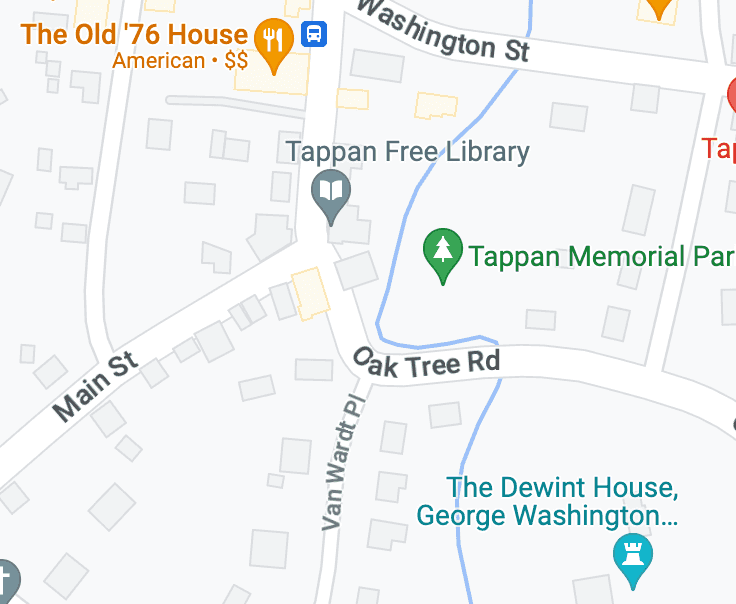 Map excerpt Tappan Tavern and George Washington's Headquarters, Tappan New York
Map excerpt Tappan Tavern and George Washington's Headquarters, Tappan New York
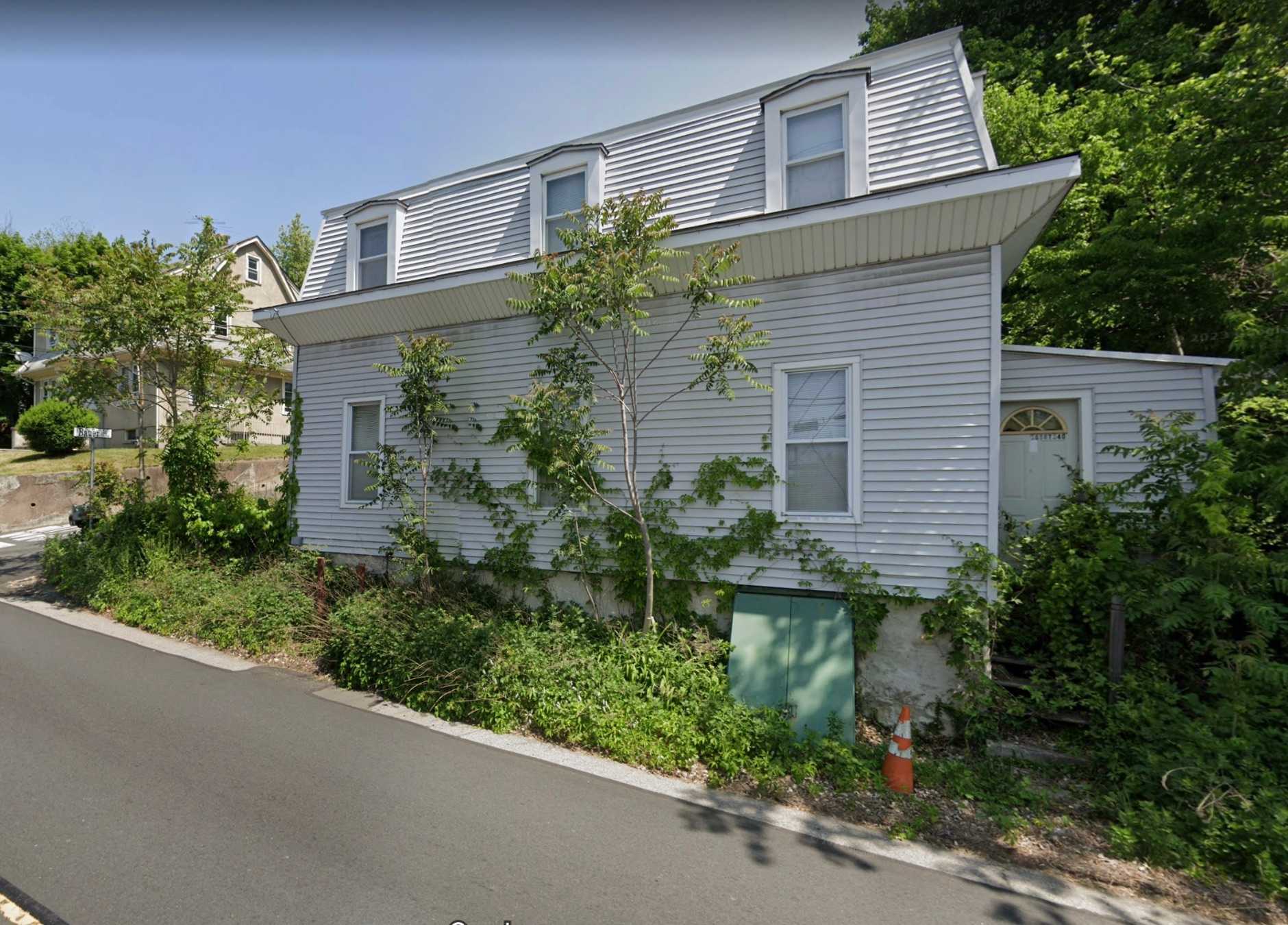 House in Sparkill NY, 365 Orangeburg Road
House in Sparkill NY, 365 Orangeburg Road
The Church
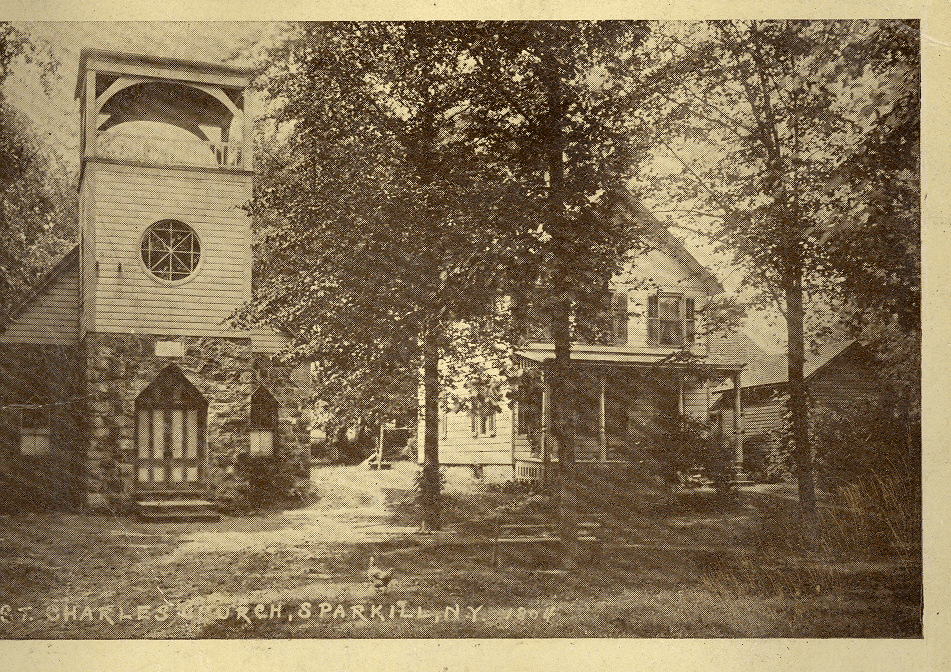 St. Charles AMEZ Church Sparkill NY ca 1804 from Lulu's journal
St. Charles AMEZ Church Sparkill NY ca 1804 from Lulu's journal
